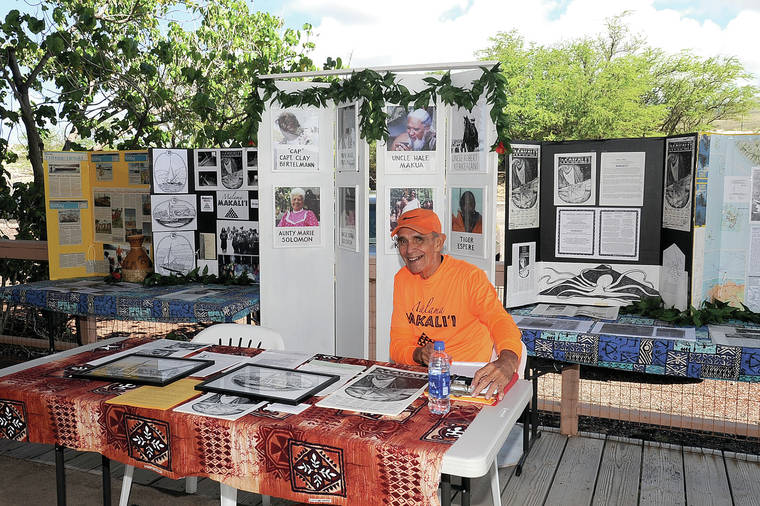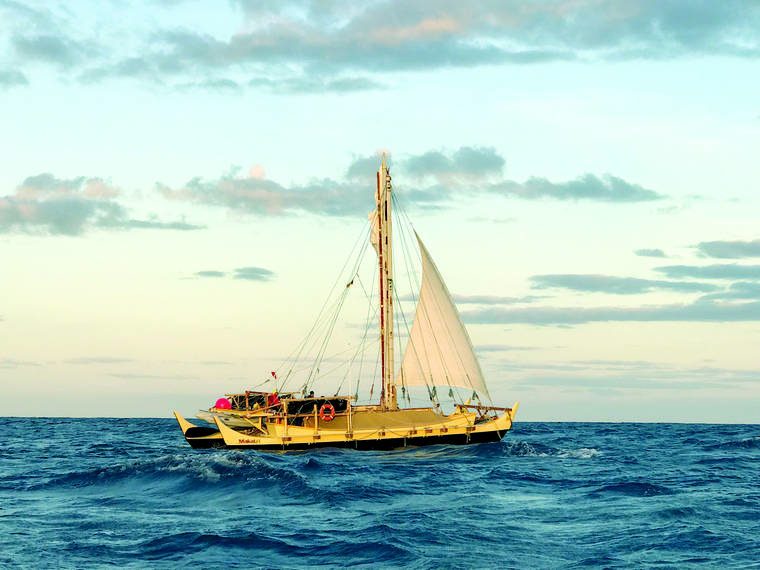Twenty-five years ago, a voyaging canoe that calls Hawaii Island home set sail on her maiden voyage to Tahiti.
On Saturday, the sailing ohana celebrated the Makali‘i with stories, memories and hope for the future.
Makali‘i was launched from Kawaihae Harbor on Feb. 4, 1995, beginning her journey to Tahiti with a crew of 10 men, including Senior Captain/Pwo (master) Navigator Chadd Paishon.
Since some crew members of Hokule‘a including Paishon lived on the Big Island and she was the only voyaging canoe of the time, they decided to build Makali‘i so the community could have access to a canoe.
Makali‘i was built in a quonset hut on Parker Ranch land in Waimea on a shoestring budget.
Paishon said originally they thought “what do cowboys know about canoes?” but traditionally they knew about mauka to makai. They knew that everything from the top of the mountain to the ocean was interconnected.
“Clay (Bertelmann) went to a lot of the elders, and they told him before you build Makali‘i, you need to build a traditional one first,” said Paishon.
And so they did.
It took them two and a half years to build that canoe in the old way, going to the forest to find the tree, practicing the protocols, going to Maunakea to get the stones to make the tools, making the rope, making the sails and finally launching from Honaunau in 1993.
After the canoe was in the water, the elders told them they were ready to build the voyaging canoe.
It took them nine months to complete Makali‘i.
“Even though Makali‘i is made out of modern materials, we understood the work that needed to go into it,” he said adding her purpose is for the community to continue what they had done with Hokule‘a.
Pomai Bertelmann, president of Na Kalai Wa‘a, the organization dedicated to offering educational experiences for the community, recalls getting the word out into the community of what was needed as they were building the vessel.
“We had $28 in our account and we needed cabosil and resin, which would cost $500,” Bertelmann said. “But that was the beauty of this community. Alii Kai boats calls and Papa Berdon says ‘hey I hear you guys need this stuff, come pick it up.’ The Charter Locker in Kona says we can have a half drum of resin. It was a beautiful thing to watch.”
She also remembered one day, after working an especially long stretch, someone from Kona came with 60 roast beef sandwiches to feed the crew. Aunties would bring big pots of stew. Parker Ranch cowboys would come after work and help them with the lashing.
“It was this beautiful imagery of who these people are and why you need the support of the community,” said Bertelmann.
“That gave the community ownership of Makali‘i,” Paishon added.
Bertelmann and a support staff of 65 met Makali‘i in Taha‘a, Tahiti, one of the canoe’s destinations on her first voyage. She proudly displayed a hook, over 2 feet in length, that was gifted to the ohana by a 17-year-old Taha‘a boy. The boy, she said, carved it from a single piece of ironwood, and the rope attached to it still looks like the day it was lashed.
“He said it was an opportunity for us to be bound together and to be braided together,” she said. “The moment was magic, extraordinary, profound, necessary essence … all of those things.”
She added they have been bound and intertwined ever since.
Makali‘i returned to Hawaii with a crew of 14 — 11 men and three women, including Bertelmann — and has been passing on the tradition ever since.
Na Kalai Wa‘a teaches aspiring young seafarers the ways of the canoe, where the find their destiny within the crew. Every position within the crew plays a vital part into a successful voyage.
“Like how our elders gave us the understanding of what we needed to do, we need to do likewise,” he said of passing the knowledge to the next generation.
When Paishon and four others were bestowed the title of master navigator in 2007 by their kumu Papa Mau Piailug, one of the last masters left in Micronesia who mentored them, they recognized that they were being responsible for feeding their people, passing on their knowledge so the people continue to thrive.
“She is for everyone,” he said. “It doesn’t matter your color, your skin, you’re Hawaiian, you’re not, it doesn’t matter. Because if you bring something, some gift, Makali‘i is here for all of us.”
“The canoe is our island and the island is our canoe. We have to stay together,” said Paishon.
“That’s the beauty of the canoe,” he said. “The dependency on each other and working together.”
And maintaining the importance of the connection between land and sea.
In 2005, Na Kalai Wa‘a was willed 10 acres in Kohala. Understanding the importance of the relationship between the canoe and the aina, the cultivated the Hoea Moku Canoe Garden Project to support Makali‘i. They grow canoe plants that support canoe construction, maintenance and sustainability like hala, hau, olona, kukui and nui. Their aim is to educate the crew, students and the community to the use and maintenance of the important plants. School groups visit, work and learn, returning with a sense of ownership of the wa‘a they have helped maintain.
“The canoe comes from the aina,” said Bertelmann. “Even if you are an ocean entity, you have to go back and malama the aina because if it wasn’t for the aina, there is no wa‘a.”
Bertelmann looks to the future and the connection to the community for Makali‘i’s continued success.
One of the biggest feats Bertelmann said, besides their first journey, is the way they are processing provisions for future voyages. About nine years ago, the organization wanted to get the community more involved with what they do.
“Not everybody wants to be a crew member,” she said. “Not everybody wants to sail. But the community wanted to help but didn’t know how.”
So the organization went out to the community and said they wanted to provision the canoe with food from Hawaii.
The community stepped up to the plate. They learned about dehydrating and smoking and other food preservation methods including freeze-drying and pickling.
Bertelmann displayed canned and freeze-dried chicken from Kamehameha Schools in Keaau, canned luau from the Hamakua Youth Center, Pork sausage from students from Punana Leo school in Waimea and freeze-dried kalua pig and even ulu pasta. That has exponentially expanded the menu and space saving of provisions needed for a voyage.
“The only way we can continue this is if the community continues to work with us,” she said. “And that gives the community onus on us.”
The community can stay involved by visiting their website at www.nakalaiwaa.org to check for dates when Makali‘i will be dockside, available for educational tours and work days. Volunteers are always welcome at the Hoea Moku garden. The organization also provides customized education to school groups, bringing their knowledge to the classroom.
“The canoe is 25 years old because the community has been so great,” said Bertelmann.
For more information, visit the website or call 885-9500.
“We know we are here because of the community, and if we remember that we’re always going to be rich,” Bertelmann said.





















